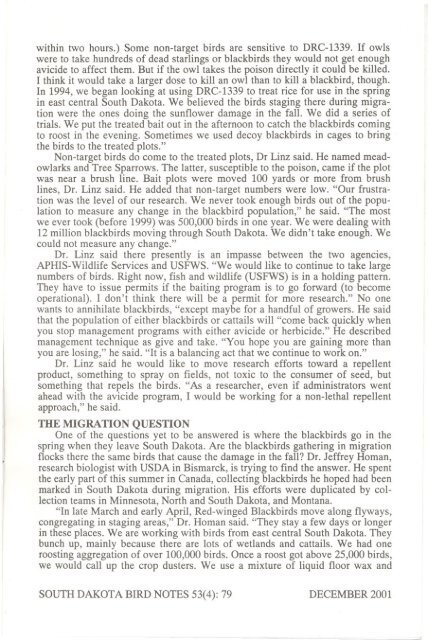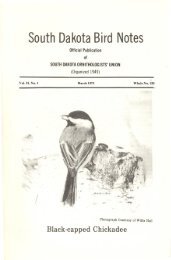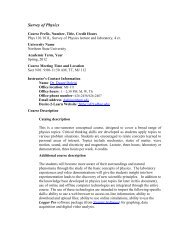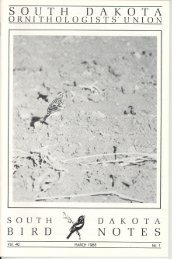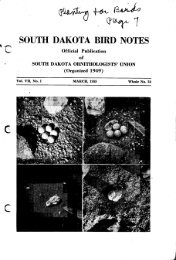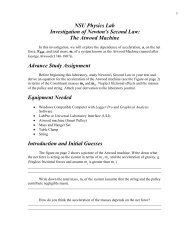-Mastrangelo said. "The hot bait is mixed with non-toxicant bait. Perhaps fourpercent of the total bait is poisoned. This particular product, DRC-1339, there'slots of research on it. Blackbirds are much more susceptible to this toxicant thanare non-blackbirds. One or two grains of treated rice will kill a blackbird. Ittakes more to kill other species. If the bait is not consumed, it is not taken up(from the bait plot). It is left in place. It breaks down within three days when exposedto ultraviolet light, and if it gets a little moisture it becomes inactive."Asked if the present request is for an operational control program or a researchprogram, Mastrangelo said, "We are still trying to decide. It's premature to labelthe program one way or the other."RESEARCHFOR SOLUTIONSDr. George Linz is the director of blackbird-sunflower studies at the GreatPlains Field Station National Wildlife Research Center in Bismarck. His work isfor USDNAPHIS/WS. His articles on blackbird control and related subjectshave been published often in industry and academic journals. "A series of studieswas carried out by North Dakota <strong>State</strong> <strong>University</strong> and the U.S. Fish andWildlife Service," he said. "They looked at how much damage to sunflowercrops, where it was happening, what species of birds were causing the problem.They looked at many non-lethal techniques for keeping the birds from thefield-lure crops on refuge land, propane cannons, high-powered rifles andshotguns fired over the field, other scare devices like eye-spot balloons. All ofthese proved to be non-cost effective."Dr. Linz took the project in 1987, and began to look at the use of glysophateherbicide. This is the chemical sprayed on cattails to kill those plants. The glysophateeffort became operational (an implemented program) in 1991."We found that when you open up the marshes you reduce the number ofblackbirds," he said. "We continue to do research on this today, on non-targetspecies, on water quality. The habitat people in fish and wildlife (USFWS) aresupportive as long as no more than 70 percent of the vegetation is taken. There isconcern about habitat loss. I believe that non-target birds are well studied here,too. On Marsh Wrens, if you take 70 percent of cattails out, that definitely reducesthe number of Marsh Wrens in that wetland. The thing we have going forus is there are a lot of Marsh Wrens out there, and lots of wetlands. They findother places to nest. Black Terns, on the other hand, nest on dead vegetationplatforms. Opening wetlands, of course, improves the habitat for waterfowl. Theglysophate treatment will decrease number of Sora rails for a year or two in thetreated wetland.""In the early 1990's we looked at using an avicide known as DRC-1339," DrLinz said. "It was developed by USFWS in the '60's to control European Starlingsin feedlots. It is perhaps the most studied vertebrate pesticide in the worldbecause it has been around so long. It is highly toxic to the family Icteridae(blackbirds, meadowlarks, cowbirds). It does not seem to affect hawks. This wasdetermined in a series of experiments; there are papers published on this. Hawksare considered non-sensitive to this chemical, but in addition, there is little avicideleft in the blackbird shortly after consumption. One good thing about thischemical is that the blackbird will excrete 90 percent of the chemical within 30minutes of ingestion, but the damage to the bird is done by that time. (A technicalnote drafted by WS in 1999 says 90 percent of the chemical is excretedSOUTH DAKOTA BIRD NOTES <strong>53</strong>(4): 78 DECEMBER <strong>2001</strong>
within two hours.) Some non-target birds are sensitive to DRC-1339. If owlswere to take hundreds of dead starlings or blackbirds they would not get enoughavicide to affect them. But if the owl takes the poison directly it could be killed.I think it would take a larger dose to kill an owl than to kill a blackbird, though.In 1994, we began looking at using DRC-1339 to treat rice for use in the springin east central South Dakota. We believed the birds staging there during migrationwere the ones doing the sunflower damage in the fall. We did a series oftrials. We put the treated bait out in the afternoon to catch the blackbirds comingto roost in the evening. Sometimes we used decoy blackbirds in cages to bringthe birds to the treated plots."Non-target birds do come to the treated plots, Dr Linz said. He named meadowlarksand Tree Sparrows. The latter, susceptible to the poison, came if the plotwas near a brush line. Bait plots were moved 100 yards or more from brushlines, Dr. Linz said. He added that non-target numbers were low. "Our frustrationwas the level of our research. We never took enough birds out of the populationto measure any change in the blackbird population," he said. "The mostwe ever took (before 1999) was 500,000 birds in one year. We were dealing with12 million blackbirds moving through South Dakota. We didn't take enough. Wecould not measure any change."Dr. Linz said there presently is an impasse between the two agencies,APHIS-Wildlife Services and USFWS. "We would like to continue to take largenumbers of birds. Right now, fish and wildlife (USFWS) is in a holding pattern.They have to issue permits if the baiting program is to go forward (to becomeoperational). I don't think there will be a permit for more research." No onewants to annihilate blackbirds, "except maybe for a handful of growers. He saidthat the population of either blackbirds or cattails will "come back quickly whenyou stop management programs with either avicide or herbicide." He describedmanagement technique as give and take. "You hope you are gaining more thanyou are losing," he said. "It is a balancing act that we continue to work on."Dr. Linz said he would like to move research efforts toward a repellentproduct, something to spray on fields, not toxic to the consumer of seed, butsomething that repels the birds. "As a researcher, even if administrators wentahead with the avicide program, I would be working for a non-lethal repellentapproach," he said.THE MIGRATION QUESTIONOne of the questions yet to be answered is where the blackbirds go in thespring when they leave South Dakota. Are the blackbirds gathering in migrationflocks there the same birds that cause the damage in the fall? Dr. Jeffrey Homan,research biologist with USDA in Bismarck, is trying to find the answer. He spentthe early part of this summer in Canada, collecting blackbirds he hoped had beenmarked in South Dakota during migration. His efforts were duplicated by collectionteams in Minnesota, North and South Dakota, and Montana."In late March and early April, Red-winged Blackbirds move along flyways,congregating in staging areas," Dr. Homan said. "They stay a few days or longerin these places. Weare working with birds from east central South Dakota. Theybunch up, mainly because there are lots of wetlands and cattails. We had oneroosting aggregation of over 100,000 birds. Once a roost got above 25,000 birds,we would call up the crop dusters. We use a mixture of liquid floor wax andSOUTH DAKOTA BIRD NOTES <strong>53</strong>(4): 79 DECEMBER <strong>2001</strong>
- Page 1:
I .SOUTH DAKOTA IORNITHOLOGISTS'UNI
- Page 4 and 5:
fication of Birds of North America
- Page 6 and 7:
- - ~1180 individuals banded and 20
- Page 8 and 9:
L--: --..Dean, K. L. 1999. Stopover
- Page 10 and 11:
I was listening to an unusual sparr
- Page 12 and 13:
..of Black-backed Woodpeckers incre
- Page 14 and 15:
.~24 Sep Meade JLB ... Late [l5-Nov
- Page 16 and 17:
..-- --- --Yankton SVS; 02 Aug Robe
- Page 18 and 19:
..American Tree Sparrow Early: 03 O
- Page 20 and 21:
PubUshed bySOUl1l DAKOTAORNI1HOLOGI
- Page 22 and 23:
SOUTH DAKOTA BIRD NOTES, the offici
- Page 24 and 25:
..ess that is being fought against.
- Page 26 and 27:
White-fronted Goose 13% 6Snow Goose
- Page 28 and 29: Hairy Woodpecker 91% 41Black-backed
- Page 31 and 32: - - -Grzybowski, 1. A. 1999. Southe
- Page 33 and 34: en0ẹ..,::r:t:J~0~OJ....:;.:;t:JZ0
- Page 35 and 36: ~A GUIDE TO THE BIRDS OF THE PHILIP
- Page 37 and 38: Brookings KIE; 11 Feb Hughes RDORed
- Page 39 and 40: TJ; 20 Jan Hughes JSP, RFSPurple Fi
- Page 41 and 42: ~!I: ORNITHOLOGISTS'I SOUTH DAKOTAU
- Page 43 and 44: ..~PRESIDENT'S PAGEI had such a bla
- Page 45 and 46: -erably prior to consulting a field
- Page 47 and 48: SUBMITTEDFOR CONSIDERATIONEurasian
- Page 49 and 50: '"young cormorants, near flight sta
- Page 51 and 52: - --"only one genus of the family S
- Page 53 and 54: ~SEASONAL REPORTSThe 2001 Spring Se
- Page 55 and 56: ----KM; 08 Apr Butte JLBCinnamon Te
- Page 57 and 58: ,-----0Apr Minnehaha RBA; 17 May Be
- Page 59 and 60: Pileated Woodpecker Only Report: 15
- Page 61 and 62: 07 MayUnion RBA ...Late: 12 May McC
- Page 63 and 64: ,I~haha RFS, JSP; 11 May Meade EEMB
- Page 65 and 66: Contributing ObserversRBADBJLBKBAPB
- Page 67 and 68: .~lSD State Lists (31 December 2000
- Page 69 and 70: - ---- JSOU T H D A K 0 r~ORNITHOLO
- Page 71 and 72: ...~PRESIDENT'S PAGEThe September m
- Page 73 and 74: emained at the refuge for 11 days b
- Page 75 and 76: _INelson has cut back sunflower pla
- Page 77: problems." He explained that Wildli
- Page 81 and 82: '\of USFWS, Mountain-Prairie Region
- Page 83 and 84: takes three days for the bird to di
- Page 85 and 86: - ,..,rcording to Gamble.NORTH DAKO
- Page 87 and 88: ~IrSMALL RESEARCH GRANTS AVAILABLE
- Page 89 and 90: ';IWhite-faced Ibis reported from H
- Page 91 and 92: Whip-poor-will Reported from Lincol
- Page 93 and 94: Meade, Pennington and Stanley co.Ea
- Page 95 and 96: REPRFSSSNSSVSDRSDSRandy E. PodollRo


